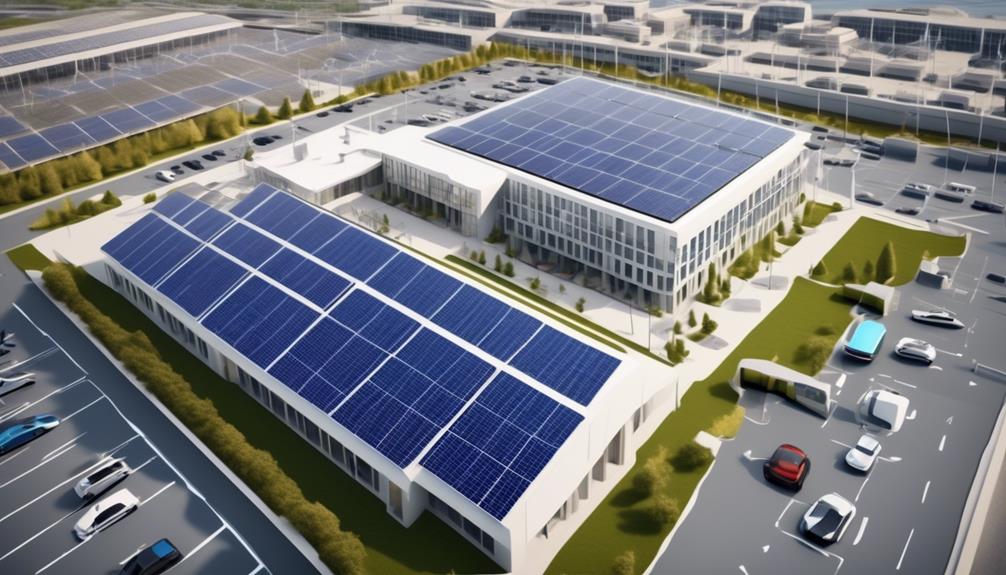Why Choose Renewable Energy to Reduce Carbon Footprint?
If you want to reduce your carbon footprint and contribute to a more sustainable future, choosing renewable energy is a crucial step. The benefits of renewable energy are numerous, and the impact it can have on the environment is significant.
But why should you consider making the switch?
Well, the reasons go beyond just environmental impact.
Benefits of Renewable Energy
Switching to renewable energy sources reduces carbon emissions, benefiting both the environment and public health. The shift to renewable energy brings about significant cost savings. Initially, there may be some investment required to set up solar panels or wind turbines, but in the long run, the operational costs are minimal. Solar panels have a lifespan of 25-30 years and require little maintenance, resulting in substantial savings compared to traditional energy sources. Additionally, wind and solar power are free, allowing you to generate your own electricity and potentially even sell excess power back to the grid, providing a source of income. This not only reduces your energy costs but also contributes to energy independence at both individual and national levels.
Furthermore, renewable energy sources contribute to energy independence. By harnessing the power of the sun, wind, and water, a nation can reduce its dependence on imported fuels. This reduces the vulnerability to volatile fuel prices and geopolitical uncertainties, providing stability and security in the energy supply. Energy independence also fosters economic growth by creating jobs in the renewable energy sector and stimulating local economies.
Types of Renewable Energy Sources
You can explore various types of renewable energy sources that offer sustainable alternatives to traditional power generation methods. Renewable energy sources are crucial in reducing carbon footprint and mitigating the effects of climate change.
Here are two major types of renewable energy sources:
- Solar Power:
- Solar power is harnessed using photovoltaic cells that convert sunlight into electricity.
- This energy source is abundant and can be utilized through solar panels installed on rooftops or in solar farms.
- Wind Energy:
- Wind energy involves harnessing the power of wind to generate electricity through wind turbines.
- This form of renewable energy is highly efficient, especially in areas with consistent and strong winds.
Both solar power and wind energy have seen significant advancements in technology and have become more affordable and accessible options for clean energy generation. These renewable sources have the potential to meet a substantial portion of global energy demand while significantly reducing greenhouse gas emissions.
Embracing these renewable energy sources not only contributes to a cleaner environment but also creates opportunities for sustainable economic development. By integrating solar power and wind energy into the energy mix, individuals and communities can contribute to a more sustainable and environmentally friendly future.
Impact on Environment
Renewable energy sources, such as solar power and wind energy, have a significant impact on the environment by reducing carbon emissions and minimizing ecological footprint.
The environmental benefits of renewable energy are substantial. Unlike traditional energy sources like coal and natural gas, renewable energy sources produce little to no greenhouse gases, leading to a drastic reduction in carbon emissions. This reduction in carbon emissions is crucial in combating climate change and its associated environmental impacts.
By harnessing renewable energy, you contribute to cleaner air and water. Traditional energy sources release harmful pollutants such as sulfur dioxide and mercury into the atmosphere and water bodies, leading to air and water pollution. However, renewable energy sources produce clean energy without emitting such pollutants, thereby significantly reducing environmental degradation.
Furthermore, renewable energy helps preserve ecosystems and biodiversity. Large-scale mining and drilling for fossil fuels often result in habitat destruction and ecosystem disruption. On the other hand, renewable energy technologies, like solar panels and wind turbines, have a minimal impact on the natural landscape, allowing ecosystems to thrive undisturbed.
Renewable Energy for Homes
Considering the benefits of renewable energy, integrating solar panels or wind turbines into your home's energy system can substantially reduce your carbon footprint. By harnessing the power of renewable sources, you not only contribute to a greener environment but also benefit from cost savings and increased energy efficiency.
- Cost Savings
- Installing solar panels or wind turbines at home may involve an initial investment, but over time, you can save significantly on your energy bills. With renewable energy sources, you can generate your own electricity, reducing your reliance on traditional power grids and lowering your overall energy costs.
- Additionally, many governments and local authorities offer financial incentives, such as tax credits or rebates, to homeowners who adopt renewable energy systems. These incentives can further offset the initial installation costs, making renewable energy more accessible and cost-effective.
- Energy Efficiency
- Renewable energy systems are designed to be highly efficient in converting natural resources into usable electricity. Solar panels and wind turbines are constantly improving in terms of efficiency, allowing you to generate more energy with fewer resources.
- By integrating renewable energy into your home, you can also take advantage of energy storage solutions, such as batteries, to store excess energy generated during peak production times. This stored energy can then be used during periods of low production, ensuring a consistent and reliable power supply while minimizing waste.
Economic Advantages
Integrating renewable energy systems into your home can lead to significant economic advantages. One of the most compelling benefits is the cost savings associated with renewable energy. By generating your own electricity through solar panels or wind turbines, you can significantly reduce or even eliminate your monthly energy bills. Over time, the initial investment in renewable energy systems can pay for itself through these savings, providing long-term financial benefits. Additionally, many governments offer incentives, such as tax credits or rebates, to encourage the adoption of renewable energy, further reducing the upfront costs and accelerating the return on investment.
Moreover, the shift towards renewable energy creates job opportunities and contributes to job creation in the green energy sector. The installation, maintenance, and manufacturing of renewable energy technologies require a skilled workforce, leading to job growth in these fields. As more households and businesses transition to renewable energy sources, the demand for workers in the renewable energy industry continues to rise, providing employment opportunities and stimulating economic development.
Renewable Energy in Transportation
When considering ways to reduce your carbon footprint, incorporating renewable energy into transportation can significantly contribute to environmental sustainability.
One of the most impactful ways to do this is by transitioning to electric vehicles (EVs). EVs are powered by electricity, which can be generated from renewable sources such as solar, wind, or hydroelectric power, making them a cleaner alternative to traditional gasoline-powered vehicles.
In addition to EVs, the use of sustainable fuels, such as biodiesel and renewable natural gas, offer promising options for reducing emissions in the transportation sector.
- Electric Vehicles:
- EVs produce zero tailpipe emissions, reducing air pollution and greenhouse gas emissions.
- The use of renewable energy to power EVs can further decrease the overall carbon footprint of transportation, making them a crucial component of sustainable mobility.
Government Incentives

To reduce your carbon footprint through renewable energy in transportation, take advantage of government incentives that promote the adoption of electric vehicles and sustainable fuels. Incentive programs and tax credits play a crucial role in making the transition to renewable energy more accessible and affordable. Many governments around the world offer various incentives to encourage individuals and businesses to choose sustainable transportation options.
In the United States, for example, the federal government provides a tax credit of up to $7,500 for the purchase of electric vehicles, depending on the vehicle's battery capacity. Additionally, some states offer additional incentives such as rebates, reduced registration fees, or access to high-occupancy vehicle lanes. These incentives can significantly offset the upfront cost of purchasing an electric vehicle, making them more financially attractive compared to traditional gasoline-powered cars.
Furthermore, governments also offer incentives to promote the use of sustainable fuels, such as biofuels and renewable diesel. These incentives can come in the form of tax credits for fuel producers, blenders, or distributors, as well as grants for research and development in the sustainable fuels sector. By taking advantage of these incentive programs, individuals and businesses can't only reduce their carbon footprint but also enjoy cost savings and contribute to a more sustainable future.
Future of Renewable Energy
The future of renewable energy holds the potential to revolutionize the way we power our world, with advancements in technology driving greater efficiency and accessibility. As innovations continue to emerge, the renewable energy sector is poised for substantial growth and impact.
- Technological Innovations: The future of renewable energy is intrinsically tied to technological advancements. Breakthroughs in energy storage, such as improved battery technology and grid management systems, are enhancing the reliability and stability of renewable power sources. Furthermore, innovations in solar panel efficiency and wind turbine design are driving down costs and increasing energy capture, making renewable energy more competitive with traditional fossil fuel sources.
- Global Adoption: The global adoption of renewable energy is rapidly accelerating, with countries around the world setting ambitious targets for clean energy deployment. This widespread adoption isn't only driven by environmental concerns but also by economic benefits and energy security. As more nations commit to renewable energy, the industry scales up, leading to further innovations and cost reductions. This global momentum is propelling the renewable energy sector into a pivotal role in the future energy landscape.
The future of renewable energy is bright, with ongoing technological innovations and global adoption paving the way for a more sustainable and resilient energy future.
Frequently Asked Questions
How Does the Use of Renewable Energy Impact National Security and Geopolitical Relationships?
Using renewable energy enhances national security by reducing dependence on foreign oil and mitigating geopolitical tensions. It bolsters energy geopolitics, providing stability and decreasing vulnerability to supply disruptions, fostering a more secure global energy landscape.
What Are the Potential Challenges and Limitations of Integrating Renewable Energy Into Existing Energy Infrastructure?
Integrating renewable energy into existing infrastructure presents challenges and limitations. Transitioning may require significant investment, technological advancements, and grid updates. However, it offers long-term benefits for the environment and energy sustainability.
How Does the Use of Renewable Energy Affect Job Creation and Employment Opportunities in the Energy Sector?
Using renewable energy can lead to job creation and economic growth. Industries like solar and wind power require skilled workers for installation and maintenance. This shift can provide employment opportunities and contribute to economic development.
What Are the Potential Social and Cultural Implications of Transitioning to Renewable Energy Sources?
Transitioning to renewable energy sources can lead to positive social acceptance and cultural adaptation. Communities embrace sustainable practices, fostering a sense of environmental responsibility. Embracing renewable energy aligns with societal values and promotes sustainable living.
Are There Any Potential Health Benefits Associated With Using Renewable Energy as Opposed to Traditional Fossil Fuels?
Using renewable energy can lead to improved air quality and public health benefits. By reducing air pollution, you can experience fewer respiratory issues and a healthier environment overall. Making the switch has positive impacts.
Conclusion
So, why choose renewable energy to reduce your carbon footprint?
Because it offers numerous benefits, including a cleaner environment, lower energy costs, and government incentives.
With various types of renewable energy sources available, you can easily integrate them into your home and transportation.
By making the switch to renewable energy, you not only save money, but also contribute to a greener future for the planet.
Make the choice for renewable energy and make a positive impact today.
